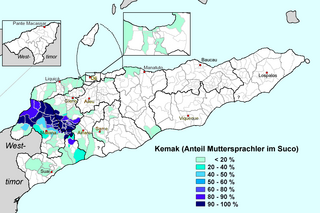
East Flemish is a collective term for the two easternmost subdivisions of the so-called Flemish dialects, native to the southwest of the Dutch language area, which also include West Flemish. Their position between West Flemish and Brabantian has caused East Flemish dialects to be grouped with the latter as well. They are spoken mainly in the province of East Flanders and a narrow strip in the southeast of West Flanders in Belgium and eastern Zeelandic Flanders in the Netherlands. Even though the dialects of the Dender area are often discussed together with the East Flemish dialects because of their location, the latter are actually South Brabantian.
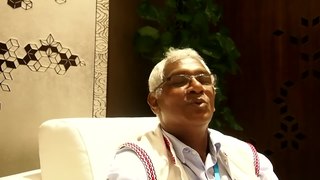
The Kharia language is a Munda language of the Austroasiatic language family, that is primarily spoken by the Kharia people of eastern India.
Naba is a Nilo-Saharan language spoken by approximately 500,000 people in Chad. Those who speak this language are called Lisi, a collective name for three closely associated ethnic groups, the Bilala, the Kuka and the Medogo, that represent the three dialects in which Naba is subdivided. They live mainly in the Batha Prefecture, but the Kuka are also in Chari-Baguirmi. Ethnologue estimates the lexical similarity among the three dialects to be no less than 99%. Arabic is often spoken as a second language.
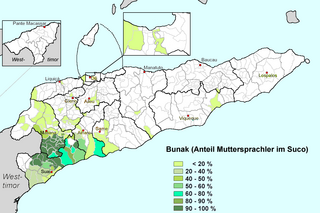
The Bunak language is the language of the Bunak people of the mountainous region of central Timor, split between the political boundary between West Timor, Indonesia, particularly in Lamaknen District and East Timor. It is one of the few on Timor which is not an Austronesian language, but rather a Papuan language of the Timor-Alor-Pantar language family. The language is surrounded by Malayo-Polynesian languages, like Uab Meto and Tetum.
Urhobo is a South-Western Edoid language spoken by the Urhobo people of southern Nigeria. It is from the Delta and Bayelsa States.

Omani Arabic is a variety of Arabic spoken in the Al Hajar Mountains of Oman and in a few neighboring coastal regions. It is the easternmost Arabic dialect. It was formerly spoken by colonists in Kenya and Tanzania, but these days, it mainly remains spoken on the island of Zanzibar.
Kairiru is one of three Kairiru languages spoken mainly on Kairiru and Mushu islands and in several coastal villages on the mainland between Cape Karawop and Cape Samein near Wewak in East Sepik Province of Papua New Guinea.
Boiken is one of the more populous of the Ndu languages of Sepik River region of northern Papua New Guinea. It is spoken around Boiken Creek in Yangoru-Saussia District, East Sepik Province and adjacent islands off the north coast of northern Papua New Guinea.
Nyimang, also known as Ama, is an East Sudanic language spoken in the Nuba Mountains of Sudan by the Nyimang people who are a sub-group of the Nuba people.
Tenetehára is a Tupi–Guarani language spoken in the state of Maranhão in Brazil. Sociolinguistically, it is two languages, each spoken by the Guajajara and the Tembé people, though these are mutually intelligible. Tembé was spoken by less than a quarter of its ethnic population of 820 in 2000; Guajajara, on the other hand, is more robust, being spoken by two-thirds of its 20,000 people.

Mao, also known as Sopvoma, is a Sino-Tibetan language of the Angami–Pochuri linguistic sub-branch. It is spoken primarily in Senapati district, northwestern Manipur and in Nagaland, India. It is similar to Angami. The speakers of this language use Meitei language as their second language (L2) according to the Ethnologue.
Gwari is a Nupoid language spoken by the Gbagyi people, which make up over a million people in Nigeria. There are two principal varieties, Gbari and Gbagyi, which have some difficulty in communication; sociolinguistically they are distinct languages.

Ute is a dialect of the Colorado River Numic language, spoken by the Ute people. Speakers primarily live on three reservations: Uintah-Ouray in northeastern Utah, Southern Ute in southwestern Colorado, and Ute Mountain in southwestern Colorado and southeastern Utah. Ute is part of the Numic branch of the Uto-Aztecan language family. Other dialects in this dialect chain are Chemehuevi and Southern Paiute. As of 2010, there were 1,640 speakers combined of all three dialects Colorado River Numic. Ute's parent language, Colorado River Numic, is classified as a threatened language, although there are tribally-sponsored language revitalization programs for the dialect.
Orokaiva is a Papuan language spoken in the "tail" of Papua New Guinea.
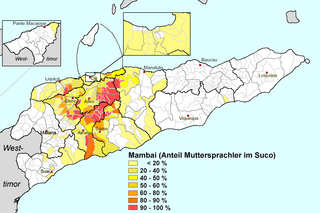
Mambai, also called Mambae or Manbae, is a language spoken by the Mambai people, the second largest ethnic group in the island country of East Timor.
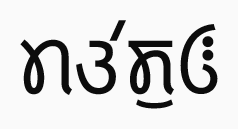
Mahasu Pahari is a Western Pahari language spoken in Himachal Pradesh. It is also known as Mahasui or Mahasuvi. The speaking population is about 1,000,000 (2001). It is more commonly spoken in the Himachal Pradesh, Shimla (Simla) and Solan districts. It is to be known that Shimla and Solan were parts of the old Mahasu district. Himachal Pradesh State on 1 September, 1972 reorganised the districts dissolving Mahasu district. The Solan district was carved out of Solan and Arki tehsils of the then Mahasu district and tehsils of Kandaghat and Nalagarh of the then Shimla District of Punjab.
Gubbi Gubbi, also spelt Kabi Kabi, is a language of Queensland in Australia, formerly spoken by the Gubbi Gubbi people of South-east Queensland. The main dialect, Gubbi Gubbi, is extinct, but there are still 24 people with knowledge of the Butchulla dialect, a language spoken by the Butchulla people of K'gari.
Ngadjunmaya correctly known as Ngadjumaya is a Pama–Nyungan language of Western Australia that is located in the Goldfields-Esperance region.
Lenakel, or West Tanna, is a dialect chain spoken on the western coast of Tanna Island in Vanuatu.
Rajbanshi is a Bengali-Assamese language spoken in Nepal. It is related to, but distinct from Rangpuri/Kamta in Bangladesh and India, which is also known by the alternative name "Rajbanshi", with which it forms the KRNB cluster.
